Body’s Building Blocks: Comprehensive Amino Acids Chart

The human body is an intricate tapestry woven together by various elements. Among them are the 20 amino acids, which play a pivotal role in our health and wellness. Dubbed the ‘building blocks’ of life, amino acids Charts are essential for various bodily functions, ranging from repairing tissues to producing energy. In this guide, we’ll take you on a remarkable journey through these amino acids Charts, providing a comprehensive chart for everyone interested in biology, health, and fitness.
A Journey Through Amino Acids Chart: A Comprehensive Chart for Every Body
When embarking on a journey through the Amino Acids Chart, it’s imperative to grasp their sheer importance. These organic compounds combine in various sequences to form proteins, which our bodies then use to repair and maintain our cells and tissues.
- Essential Amino Acids vs. Non-Essential Amino Acids
- Essential Amino Acids: These cannot be produced by the body and thus must be obtained from our diet.
- Non-Essential Amino Acids: The body can produce these, so they don’t necessarily need to come from our food intake.
- Why are Amino Acids called Building Blocks?
- Their crucial role in constructing proteins
- Facilitation of neurotransmitter processes
- Amino Acids Chart and Their Influence on Mood and Behavior
- How Tryptophan influences serotonin production
- The role of Tyrosine in dopamine synthesis
Amino Acids chart
| Amino Acid Chart |
|---|
| Alanine |
| Arginine |
| Asparagine |
| Aspartic Acid |
| Cysteine |
| Glutamic Acid |
| Glutamine |
| Glycine |
| Histidine |
| Isoleucine |
| Leucine |
| Lysine |
| Methionine |
| Phenylalanine |
| Proline |
| Serine |
| Threonine |
| Tryptophan |
| Tyrosine |
| Valine |
Breaking Down the Amino Acid Chart

Breaking Down the Amino Acid Chart
Amino acids, often termed the ‘building blocks of life,’ are fundamental to many bodily processes. There are 20 amino acids in the Amino Acids Chart list that serve as the building blocks for proteins. Let’s break them down:
1. Histidine
Role: Histidine is primarily used in the body to develop and maintain healthy tissues. It’s crucial for the maintenance of the myelin sheaths, which surround nerve cells and ensure the transmission of electrical signals in the nervous system.
Sources: Fish, poultry, meat, dairy, and some grains.
2. Isoleucine
Role: Classified as a branched-chain amino acid, Isoleucine plays a pivotal role in muscle metabolism. It contributes to energy production and is essential for hemoglobin formation.
Sources: Eggs, fish, chicken, lentils, almonds.

Isoleucine
3. Leucine
Role: Like Isoleucine, Leucine is another branched-chain amino acid that significantly aids in protein synthesis and muscle repair. It also regulates blood sugar levels, stimulates wound healing, and produces growth hormones.
Sources: Soybeans, beef, lamb, pork, seeds, nuts, and fish.
4. Lysine
Role: Lysine is essential for the synthesis of proteins, aiding in muscle turnover and repair. Additionally, it supports the absorption of calcium and plays a role in the formation of collagen – a key component for bones, skin, and tendons.
Sources: Meat, eggs, soy, black beans, quinoa.
5. Methionine
Role: Apart from protein synthesis, Methionine is crucial for the absorption of selenium and zinc, minerals vital for health. It also plays a role in the production of molecules like creatine, which provide energy to tissues.
Sources: Brazil nuts, fish, meats, dairy products, and wheat germ.
6. Phenylalanine
Role: Phenylalanine exists in two forms: L-phenylalanine (a natural form present in proteins) and D-phenylalanine (a synthetic mirror image). It’s a precursor to neurotransmitters like dopamine, epinephrine, and norepinephrine.
Sources: Dairy, meat, poultry, fish, and certain nuts and seeds.
7. Threonine
Role: Threonine supports healthy function in the central nervous system, cardiovascular system, liver, and immune system. It’s a key component in collagen, elastin, and enamel proteins.
Sources: Leafy vegetables, meat, poultry, and mushroom.
8. Tryptophan
Role: Often associated with post-Thanksgiving sleepiness, Tryptophan is a precursor to the neurotransmitter serotonin. Serotonin regulates mood, sleep, and appetite.
Sources: Turkey, chicken, nuts, cheese, and tofu.
9. Valine
Role: Valine, another branched-chain amino acid, aids in muscle metabolism, tissue repair, and the maintenance of proper nitrogen balance in the body.
Sources: Cheese, vegetables, mushrooms, peanuts, and soy protein.
10. Arginine
Role: Arginine is essential for many physiological processes, including wound healing, detoxification, and immune system functioning. It also plays a role in producing nitric oxide, a compound that relaxes blood vessels.
Sources: Seeds (like sunflower and sesame), nuts, meat, dairy, and grains.
11. Alanine
Role: Alanine plays a key role in transferring nitrogen from peripheral tissue to the liver. It also aids in the metabolism of glucose, a simple sugar that provides energy to the body.
Sources: Meat, seafood, beans, nuts, and seeds.
12. Asparagine
Role: This amino acid plays a significant role in the synthesis of other amino acids. It’s also involved in metabolic control processes within nerve and brain cells.
Sources: Dairy, whey, beef, poultry, eggs, fish, and seafood.
13. Aspartic Acid (or Aspartate)
Role: Aspartic acid plays a pivotal role in the citric acid cycle, or Krebs cycle, which is central to energy production. It’s also involved in transaminase activity and DNA metabolism.
Sources: Animal sources like poultry, beef, wild game, and plant sources like avocado and asparagus.
14. Cysteine
Role: Cysteine has antioxidant properties, supports detoxification, and promotes the formation of skin, hair, and nails. It also plays a role in metabolic processes and the activity of various enzymes.
Sources: Poultry, yogurt, egg yolks, red peppers, garlic, onions, broccoli, and Brussels sprouts.
15. Glutamic Acid (or Glutamate)
Role: This amino acid is a key player in cellular metabolism. It acts as a neurotransmitter in the brain and is involved in learning and memory.
Sources: Foods high in protein like meats, dairy, eggs, and fish.
16. Glutamine
Role: Glutamine supports gut health, immune function, and other metabolic processes. It’s also the primary fuel source for cells in the intestines.
Sources: Beef, chicken, fish, eggs, and milk.
17. Glycine
Role: Glycine is vital for the synthesis of other non-essential amino acids. It’s also a component of collagen, promoting skin, cartilage, and muscle health. Furthermore, glycine aids in the processing of genetic material.
Sources: Meat, fish, dairy, and legumes.
18. Proline
Role: Proline is essential for collagen formation, ensuring skin elasticity and maintaining joint and tendon health. It also contributes to cardiovascular health.
Sources: Egg whites, dairy, meat, and soy products.
19. Serine
Role: Serine plays a role in metabolism, assisting in the formation of DNA and RNA. It’s also involved in muscle formation and immune system function.
Sources: Soybeans, peanuts, walnuts, and chickpeas.
20. Tyrosine
Role: Tyrosine is essential for producing neurotransmitters that regulate mood, among them dopamine, norepinephrine, and epinephrine. It’s also involved in melanin production, which determines skin and hair color.
Sources: Dairy products, meats, fish, eggs, beans, oats, and wheat.
Also, read EAA Powder Uses: Unleashing The Power Of Essential Amino Acids
Getting the Most Out of Your Amino Acids Chart Through Diet
Understanding the amino acids Chart is just half the battle. Knowing which foods are rich in specific amino acids Charts can be a game-changer.
- Poultry and Meats: Chicken, turkey, and beef are excellent sources of several essential amino acids.
- Seafood: Beyond being a heart-healthy option, fish like salmon offer a plethora of amino acids.
- Plant-Based Sources: Lentils, chickpeas, and quinoa can be invaluable for vegetarians and vegans.
Amino Acids Chart in Sports and Fitness
For those who are into fitness, understanding amino acids can be a boon.
- Branch-Chained Amino Acids (BCAAs) and Muscle Recovery
- Enhancing Workout Performance with Amino Acid Supplements
- Protein Shakes: Are They Worth the Hype?
Conquering Myths about Amino Acids Chart
Like many aspects of nutrition and biology, amino acids Charts have their share of myths.
Myth: All Protein Sources Provide the Same Amino Acids Chart Profiles.
Reality: This is a common misconception. While all proteins are made up of amino acids, not all protein sources provide the same array or proportion of these amino acids. There are 20 standard amino acids in the Amino Acids Chart list, nine of which are termed “essential” because they can’t be produced by the body and must be obtained through our diet. Animal-based protein sources, such as meat, dairy, and eggs, typically provide all the essential amino acids in the quantities our bodies need and are thus considered “complete” proteins.
In contrast, many plant-based protein sources are missing one or more essential amino acids, so they’re often termed “incomplete” proteins. However, by combining different plant-based foods (like beans and rice), you can get all the essential amino acids, even from plant sources.
Myth: Overconsumption of Amino Acid Supplements Can’t Hurt
Reality: Like with many supplements, the mantra “more is better” doesn’t apply. Overconsumption of amino acid supplements can lead to several side effects. For instance, excessive intake of branched-chain amino acids (BCAAs) may lead to an imbalance in the levels of other essential amino acids in the body.
Additionally, high doses of amino acids can lead to gastrointestinal issues, nausea, headaches, and even more severe health concerns, such as an increased risk of certain diseases. Furthermore, some amino acids might interact with medications or exacerbate pre-existing health conditions. It’s crucial to consult with a healthcare professional before starting any supplementation.
Myth: Only Athletes Need to Focus on Amino Acid Intake
Reality: While athletes and those who engage in intense physical activities may have higher protein and amino acid requirements, everyone needs amino acids for overall health and well-being. Amino acids play a vital role in numerous physiological processes, including tissue repair, nutrient absorption, neurotransmitter function, and immune system support.
Therefore, whether you’re an athlete or not, it’s essential to ensure you’re getting adequate amino acids in your diet. For those who follow a vegetarian or vegan diet, it becomes especially important to ensure that they are consuming a variety of plant-based proteins to get all the essential amino acids.
FAQs
Why are amino acids essential for our body?
Amino acids serve as the foundational building blocks of proteins, which are vital for several body functions, including tissue repair and hormone production.
How can I ensure I’m getting a balanced intake of amino acids in my diet?
Diversifying your protein sources, including meats, dairy, seafood, and plant-based proteins, can help ensure a balanced intake.
What’s the difference between amino acids and proteins?
While amino acids are the building blocks that combine in various sequences to form proteins, proteins are complex structures that play numerous roles in the body.
Is it necessary to take amino acid supplements?
While many people can get their required amino acids from a balanced diet, athletes or individuals with certain medical conditions might benefit from supplements. However, it’s essential to consult with a healthcare professional first.
Are there any side effects to consuming excessive amino acids?
Overconsumption can lead to potential side effects, including gastrointestinal issues, and in extreme cases, can negatively impact the kidneys or liver.
Which foods are the best sources of amino acids?
Poultry, meats, fish, dairy products, and plant-based sources like lentils and chickpeas are excellent sources.
Conclusion
Embarking on “A Journey Through Amino Acids Chart: A Comprehensive Chart for Every Body” allows us to recognize the immense power and influence of these tiny compounds. They are more than just building blocks; they’re the essence of life itself, guiding countless functions and processes in our bodies. Understanding them is not only a journey through biology but also a journey of self-discovery and wellness.
External Resources
- Water Intake Calculator: Everything You Need to Know - September 7, 2024
- 5 Weight Gain Drink Recipes for Healthy Bulking - March 29, 2024
- High-Calorie Banana Shake for Weight Gain - March 27, 2024








